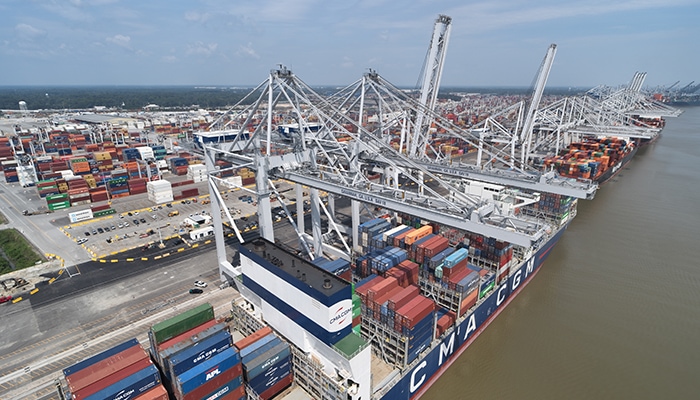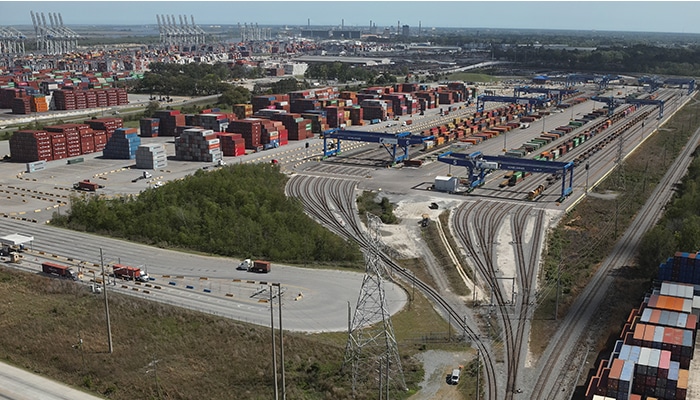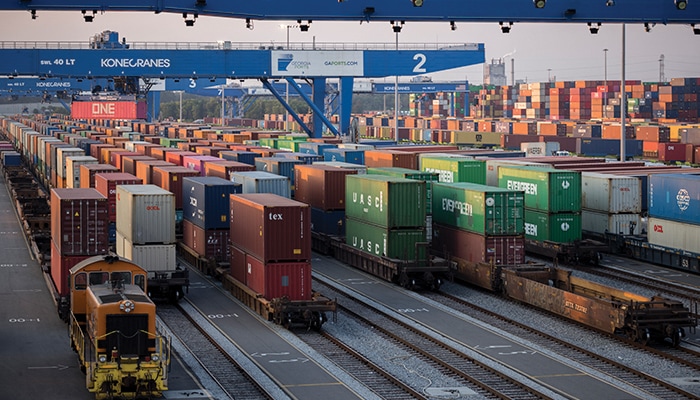How to Make a Site Selection Slam Dunk

Your best shot for finding the right site for your distribution center, warehouse, or manufacturing facility? Court these moves and zone in on these resources for winning plays.
On the seemingly boundless list of decisions that business owners and executives must make to score site selection wins, their initial choice is often the most important one: where to start or continue the journey, or create a new or additional path forward. It starts with the well-known real estate mantra. Shall we chant it together? Location, location, location.
In the logistics arena, the real estate mantra sets up the winning play. Pinpointing the right location determines the effectiveness or failure of all that follows.
As basketball star LeBron James, who knows a thing or two about picking his spots, once said: “If I’m on the court and I throw a pass, the ball that I’ve thrown will lead my teammate right where he needs to go, before he even knows that that’s the right place to go.”
The same is true in logistics. Knowing where your products need to go and how to get them there as quickly and efficiently as possible—whether through road, rail, intermodal, air, or sea—is at the essence of the supply chain playbook.
Understanding the critical factors a company needs to consider in determining where to locate a warehouse, distribution center, or manufacturing facility is essential to the decision-making process.
Site selection experts tell us those factors include access to customers, transportation modes, workforce, utilities, and business services. All these factors must be weighed in the context of cost and potential revenue.
In addition, the “soft” factors of lifestyle—such as climate, culture, recreation, and available educational opportunities for families—are likewise intrinsic to the process both formally and informally.
If you work where you live, you—that is, employees and management—want to work in a community that brings you comfort, fulfillment, and pleasure as well as business success.
Getting in the Zone
Is there one “perfect” spot that satisfies all your individual and company goals? Fortunately, there are plentiful resources to help you sort out the options—site selection consultants, community economic-development organizations, commercial real estate firms, and professionals from logistics providers such as ports—as well as the leaders of your company’s own internal operating departments.
Working in tandem, your site selection team should have the expertise to review all the critical location factors, sift through the data, and reach a consensus.
The winning move is finding consensus. Unless all disciplines within the organization are fairly consulted, the potential that the process—and, therefore, the result—will be flawed is dramatically increased.
Moving from a long list of possibilities to a short list of finalists will involve extensive research as well as financial modeling, location analysis, and site visits, all of which will have the bonus of helping you achieve a better understanding of your company’s strengths, weaknesses, and goals across the entire organization.
You may be tempted to believe the importance of physical location has been diminished in the digital age. That notion is far removed from reality, according to Edward (Ned) Hill, a site selection authority and professor of economic development in the John Glenn College of Public Affairs at The Ohio State University.
“Location is the gateway to talent, customers, knowledge, and suppliers,” Hill says.
Whether virtual, actual, or a combination of the two, your tours of potential sites are likely to introduce your team to location possibilities that were not at the top of the list when the selection process began. For that reason, it is vital to trust guides who know the territory.

Offering businesses increased supply chain efficiencies, the newly redesigned Container Berth 1 at the Port of Savannah’s Garden City Terminal can simultaneously serve seven ships, including four vessels with a capacity of 16,000+ TEUs. The upgraded berth boosted capacity by 25%.
Winning Ways: Georgia’s Ports
The southern region of the United States is of keen interest to site selection teams due to its strategic logistics location and assets, not the least of which are its port assets represented by the Georgia Ports Authority (GPA).
“The population of the U.S. Southeast is growing faster than any other region of the country, and manufacturers are flocking to the area’s business-friendly states,” says Griff Lynch, the GPA’s president and CEO. “Overseas, production is shifting to locations such as India and Vietnam that favor delivery via Savannah.”
From 2020 to 2022, the population of the U.S. South increased by 2.3 million people, according to U.S. Census data. Comparatively, the population of the Western United States grew by only 92,000.
“As the nation’s fastest-growing region, the South is seeing increased consumer demand, which translates into higher port volumes,” Lynch says.
“The area has also seen strong growth in manufacturing, including the recent announcement of the Hyundai Metaplant,” he adds. “The carmaker is poised to establish a whole new ecosystem of auto manufacturing and ancillary suppliers moving cargo through Georgia’s deep-water ports.”
Lynch says producers are drawn to the Port of Savannah’s market area by the South’s lower operating costs, growing population base, and logistical advantages.
Stacy Watson, director of economic and industrial development for Georgia Ports Authority, points out, for example, that 45% of the U.S. population is accessible via intermodal rail service from the Port of Savannah. The port’s service area ranges in an arc from Dallas to Chicago.
“No other port community in the nation provides more targeted workforce training or more room to grow than Savannah,” Watson says. “With multiple universities in the region and the state’s Quick Start program, industries can rely on Georgia for well-trained employees at every level.”
Quick Start is one of Georgia’s most important economic development incentives for attracting new investment to the state and promoting job creation. The internationally acclaimed program provides customized training free of charge to qualified new, expanding, and existing businesses.
Another important factor that businesses should consider in their site selection deliberations is the superior connectivity to global markets available through the Port of Savannah.
“With the most weekly vessel calls of any port in the mid-Atlantic, Southeast, or Gulf coasts, the Port of Savannah offers more options to more locations,” adds Watson. “On-terminal rail and direct truck routes from the terminal gates to interstates 95 and 16 mean greater efficiency in cargo flow from the port to industrial corridors and retail markets.”
There is ample land permitted for private development within 30 miles of the port, and in a developing market of properties an easy 40- to 45-mile drive from the port.
At 1,500 acres and nearly 10,000 feet of contiguous berth space, the Port of Savannah’s Garden City Terminal is the Western Hemisphere’s largest single-operator container terminal.
Its gates process approximately 12,500 truck transactions per day. It takes only 34 minutes for drivers to drop off an export container and depart the terminal. Dropping off an export container and picking up an import takes only 53 minutes.

The Port of Savannah’s Mason Mega Rail Terminal offers 85 acres of on-port rail capacity. Georgia Ports Authority and CSX provide 7-day-a-week rail departures between the Mason Mega Rail Terminal and the railroad’s terminal in Rocky Mount, North Carolina.
Calling the Shots
When all is said and done, it is vital that everyone on your site selection team has a comprehensive understanding of precisely what it is the company is seeking to accomplish in its new or expanded location.
“Is the search strategic or tactical?” asks Ohio State’s Ned Hill. “If it is a ‘fire drill’ to solve an immediate production or space problem, the dangers of making a long-term mistake are increased. If the goals are part of a long-term strategy, the entire location team needs to share the same vision.
“Is everyone clear on the purposes of the proposed facility?” Hill asks. “Another way of saying this is to ask what problem will be solved or what opportunity is being taken.”
Once you answer those questions, and establish and understand your goals, you can tackle the more specific and practical questions about individual potential sites—including environmental factors, zoning issues, and site-preparation costs—with the help of the government, as well as the utility, commercial real estate, and transportation leaders in the community.
Just as in logistics itself, if you properly execute the site selection playbook, you will score exactly the right location for your new facility.
Play-by-Play
How consensus drives the process of selecting a location
Whether for a distribution center, warehouse, or manufacturing facility, the community site selection process usually can be completed within three to four months. Edward (Ned) Hill, professor of economic development in the John Glenn College of Public Affairs at The Ohio State University, cites the following key 10 steps in the selection process:
1. Assemble your team (internal and consultant).
2. Define goals, objectives, and key operational concerns.
3. Establish consensus on steps 1 & 2.
4. Define your business model and corporate culture.
5. Create a project timeline.
6. Establish consensus on steps 3 & 4.
7. Identify factors and variables critical to the company’s success.
8. Establish consensus on step 7.
9. Rank the regions under consideration.
10. Establish consensus on step 9 before commencing to identify specific potential properties.

